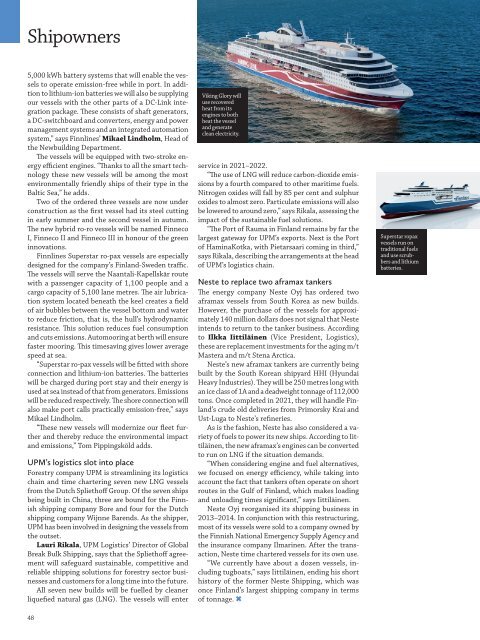You also want an ePaper? Increase the reach of your titles
YUMPU automatically turns print PDFs into web optimized ePapers that Google loves.
Shipowners<br />
5,000 kWh battery systems that will enable the vessels<br />
to operate emission-free while in port. In addition<br />
to lithium-ion batteries we will also be supplying<br />
our vessels with the other parts of a DC-Link integration<br />
package. These consists of shaft generators,<br />
a DC-switchboard and converters, energy and power<br />
management systems and an integrated automation<br />
system,” says Finnlines’ Mikael Lindholm, Head of<br />
the Newbuilding Department.<br />
The vessels will be equipped with two-stroke energy<br />
efficient engines. “Thanks to all the smart technology<br />
these new vessels will be among the most<br />
environmentally friendly ships of their type in the<br />
Baltic Sea,” he adds.<br />
Two of the ordered three vessels are now under<br />
construction as the first vessel had its steel cutting<br />
in early summer and the second vessel in autumn.<br />
The new hybrid ro-ro vessels will be named Finneco<br />
I, Finneco II and Finneco III in honour of the green<br />
innovations.<br />
Finnlines Superstar ro-pax vessels are especially<br />
designed for the company’s Finland-Sweden traffic.<br />
The vessels will serve the Naantali-Kapellskär route<br />
with a passenger capacity of 1,100 people and a<br />
cargo capacity of 5,100 lane metres. The air lubrication<br />
system located beneath the keel creates a field<br />
of air bubbles between the vessel bottom and water<br />
to reduce friction, that is, the hull’s hydrodynamic<br />
resistance. This solution reduces fuel consumption<br />
and cuts emissions. Automooring at berth will ensure<br />
faster mooring. This timesaving gives lower average<br />
speed at sea.<br />
“Superstar ro-pax vessels will be fitted with shore<br />
connection and lithium-ion batteries. The batteries<br />
will be charged during port stay and their energy is<br />
used at sea instead of that from generators. Emissions<br />
will be reduced respectively. The shore connection will<br />
also make port calls practically emission-free,” says<br />
Mikael Lindholm.<br />
“These new vessels will modernize our fleet further<br />
and thereby reduce the environmental impact<br />
and emissions,” Tom Pippingsköld adds.<br />
UPM’s logistics slot into place<br />
Forestry company UPM is streamlining its logistics<br />
chain and time chartering seven new LNG vessels<br />
from the Dutch Spliethoff Group. Of the seven ships<br />
being built in China, three are bound for the <strong>Finnish</strong><br />
shipping company Bore and four for the Dutch<br />
shipping company Wijnne Barends. As the shipper,<br />
UPM has been involved in designing the vessels from<br />
the outset.<br />
Lauri Rikala, UPM Logistics’ Director of Global<br />
Break Bulk Shipping, says that the Spliethoff agreement<br />
will safeguard sustainable, competitive and<br />
reliable shipping solutions for forestry sector businesses<br />
and customers for a long time into the future.<br />
All seven new builds will be fuelled by cleaner<br />
liquefied natural gas (LNG). The vessels will enter<br />
Viking Glory will<br />
use recovered<br />
heat from its<br />
engines to both<br />
heat the vessel<br />
and generate<br />
clean electricity.<br />
service in <strong>2021</strong>–2022.<br />
“The use of LNG will reduce carbon-dioxide emissions<br />
by a fourth compared to other maritime fuels.<br />
Nitrogen oxides will fall by 85 per cent and sulphur<br />
oxides to almost zero. Particulate emissions will also<br />
be lowered to around zero,” says Rikala, assessing the<br />
impact of the sustainable fuel solutions.<br />
“The Port of Rauma in Finland remains by far the<br />
largest gateway for UPM’s exports. Next is the Port<br />
of HaminaKotka, with Pietarsaari coming in third,”<br />
says Rikala, describing the arrangements at the head<br />
of UPM’s logistics chain.<br />
Neste to replace two aframax tankers<br />
The energy company Neste Oyj has ordered two<br />
aframax vessels from South Korea as new builds.<br />
However, the purchase of the vessels for approximately<br />
140 million dollars does not signal that Neste<br />
intends to return to the tanker business. According<br />
to Ilkka Iittiläinen (Vice President, Logistics),<br />
these are replacement investments for the aging m/t<br />
Mastera and m/t Stena Arctica.<br />
Neste’s new aframax tankers are currently being<br />
built by the South Korean shipyard HHI (Hyundai<br />
Heavy Industries). They will be 250 metres long with<br />
an ice class of 1A and a deadweight tonnage of 112,000<br />
tons. Once completed in <strong>2021</strong>, they will handle Finland’s<br />
crude old deliveries from Primorsky Krai and<br />
Ust-Luga to Neste’s refineries.<br />
As is the fashion, Neste has also considered a variety<br />
of fuels to power its new ships. According to Iittiläinen,<br />
the new aframax’s engines can be converted<br />
to run on LNG if the situation demands.<br />
“When considering engine and fuel alternatives,<br />
we focused on energy efficiency, while taking into<br />
account the fact that tankers often operate on short<br />
routes in the Gulf of Finland, which makes loading<br />
and unloading times significant,” says Iittiläinen.<br />
Neste Oyj reorganised its shipping business in<br />
2013–2014. In conjunction with this restructuring,<br />
most of its vessels were sold to a company owned by<br />
the <strong>Finnish</strong> National Emergency Supply Agency and<br />
the insurance company Ilmarinen. After the transaction,<br />
Neste time chartered vessels for its own use.<br />
“We currently have about a dozen vessels, including<br />
tugboats,” says Iittiläinen, ending his short<br />
history of the former Neste Shipping, which was<br />
once Finland’s largest shipping company in terms<br />
of tonnage. ✖<br />
Superstar ropax<br />
vessels run on<br />
traditional fuels<br />
and use scrubbers<br />
and lithium<br />
batteries.<br />
48

















